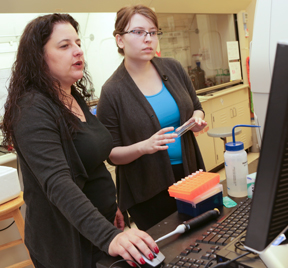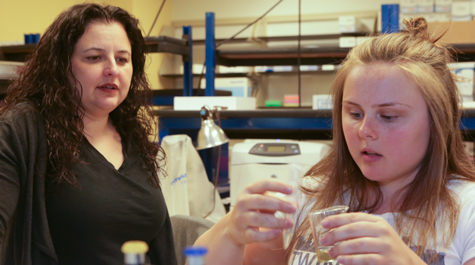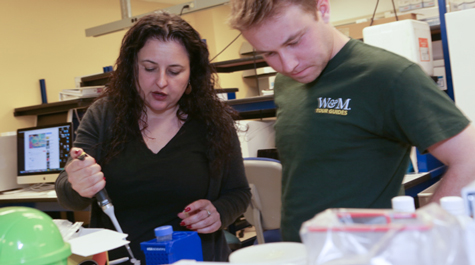This lab studies the social interaction of yeast. Yes, yeast.
Yeast don’t have much of a social life; they’re single-celled fungi, after all. But yeast are, indeed, social.
Social interaction among humans might center around protein shakes and discussion of films. Yeast are more into protein handshakes and formation of biofilms.
Helen Murphy leads a group of William & Mary researchers working to understand yeast society, which is both important and interesting to scientists.
“When people think about Saccharomyces cerevisiae, they think about making wine and baking bread, doing all the things that Saccharomyces has done for us ever since we’ve domesticated it,” Murphy said. “But it’s also a really important biomedical organism.”
Along with bakers, brewers and vintners, scientists are very interested in this particular yeast species. It’s one of the most-studied organisms on earth. S. cerevisiae, when they’re doing the heavy biochemical lifting in leavening and fermentation, are our friends indeed.
Murphy is an assistant professor in William & Mary’s Department of Biology. She has received support for her lab’s investigation into yeast from the National Institutes of Health as well as a recent grant from the National Science Foundation.
 Murphy explained that beyond wine and bread, S. cerevisiae is so important to scientists because it’s a eukaryote. Eukaryotes are organisms with cells that are enclosed inside membranes. Oak trees are eukaryotes. Dogs are eukaryotes. S. cerevisiae are cheap, easy to work with and reproduce quickly.
Murphy explained that beyond wine and bread, S. cerevisiae is so important to scientists because it’s a eukaryote. Eukaryotes are organisms with cells that are enclosed inside membranes. Oak trees are eukaryotes. Dogs are eukaryotes. S. cerevisiae are cheap, easy to work with and reproduce quickly.
“Plants, animals, just about everything we care about are eukaryotes,” Murphy explained. “And that means when we study the cellular processes within yeast, we’re learning a lot about how a lot of multicellular life might work.”
She added that a large number of the principles of cell biology and genetics were first figured out by studying Saccharomyces cerevisiae. Like all yeasts, S. cerevisiae reproduce quickly: Murphy’s lab will produce six to seven generations per day, making it an ideal organism to study evolution.
“We can do all these crazy things, like evolve yeast populations and freeze them along the way,” she said. “It’s basically like having frozen dinosaurs. You can bring yeast back to life. It is like being able to go into the evolutionary record, resurrect some fossil and compare it to a modern-day animal.”
Murphy’s found that yeast can develop surprisingly complex cooperative arrangements. Her lab just submitted a paper about a protein that sits atop yeast cells. The molecule allows the yeast cells to adhere to each other and Murphy says it seems that the protein functions as a self-recognition mechanism, enabling individual yeast cells to selectively bind with their closest genetic kin. It’s just one aspect of yeast society, which she points out can be surprisingly varied.
“Most people don’t think about microorganisms as social,” she said. “People think they’re just cells, floating around in the environment, maybe interacting with the abiotic world. But in fact, most microorganisms live in little spatial communities and engage in all sorts of interactions, ranging from deadly lethal warfare with toxins all the way up to cooperation, quorum sensing and biofilm formation.”
Yeast like to form their little mutual-assistance societies with their closest kin; Murphy says that’s no surprise, as when animals engage in cooperative behavior, most of the time that’s evolved through relatives helping each other.
“You don’t tend to see nonrelated organisms being altruistic or cooperating with each other,” she said. “That’s not how evolution works. You sort of favor your own genome through your relatives. And that’s what we’re finding in yeast.”
Murphy’s lab team members are mostly undergraduates: “They are awesome. I love each of my students — each of them in a different way.”
The lab is tasked with breeding hundreds and hundreds of generations of an organism, plus examining the characteristics and keeping track of each. Churning out the evolving generations of yeast requires constant, intense wet lab work by Alec Friedman ’19, Amanda Ivanoff and Sophie Harris ’19.
Juliana Salcedo ’20 is the lead person for evolution study in the lab. There is a large computational aspect of the project, which is largely the domain of Meliha Ahmad, a biomath major.
“She is just tearing through a bunch of genomic data this summer,” Murphy said.
Once a family of S. cerevisiae gets it into whatever passes for their minds to form a biofilm, the researchers will begin to see the strain moving together into what Murphy describes as “little flowers.” The flower formations are a sign that the yeast cells are getting organized. Each strain forms its own predictable extracellular matrix, too.
“They’re excreting something that allows them to attach into sort of a community architecture,” Murphy explained. Researchers are just starting to understand the yeastly benefits of living in such a community. Murphy said for one thing, studies have shown that the architecture retains more water, which is good for the yeast.
“The other thing that’s amazing is that there are drug efflux pumps,” she said. “In other words, little pumps on the outside of the cell that literally pump away antibiotics and other drugs that you would apply.”
The little protective pumps are only found on the outside of the yeast colony, she said — they’re protecting the colony. It’s one more example of the benefits yeast can engineer by genetic differentiation.
A social group prospers only when everyone is playing nice, but in yeast communities as well as human communities, there is always one individual who manages to benefit from the community without contributing anything to it. Murphy recently received funding from the NSF’s Division of Environmental Biology to pursue turning such “cheater” yeast cells into Trojan Horses that would be able to break down the community’s biological defenses.
Murphy said that it’s mostly wild strains of S. cerevisiae that start forming — and defending — their colonies. The beer-and-bread strains have been bred to be docile servants of fertilization, but she added that they do occasionally run wild and start forming biofilms. The brewer or baker just has a bad batch, usually not suspecting that mutation is at the bottom of it.
Because the yeast reproduce so quickly, they evolve new strains. Sometimes a strain will become virulent, and the usually benign yeast evolves into something that can produce stubborn infections.
Murphy says that yeast society has cast the occasional dark spot into the long and usually beneficial history between human and yeast. Healthy people usually don’t host Saccharomyces cerevisiae communities, but Murphy said they can be found in vaginas and lungs of immunocompromised individuals.
Human-health problems involving yeast are more often caused by another species, Candica albicans. It is not just a tenacious and unwanted presence in human tissue, but also can take up residence on the surface of medical devices.
“You can get a Candica albicans biofilm on a catheter,” she said. “They go into this different kind of growth form — and it’s so hard to get rid of!”
Murphy explained that when yeast group together in a biofilm, the community can develop super resistance to antibiotics. “The whole idea of the biofilm community is to have resistance to any sort of environmental stress,” she added.
A social group prospers only when everyone is playing nice, but in yeast communities as well as human communities, there is always one individual who manages to benefit from the community without contributing anything to it. Murphy recently received funding from the NSF’s Division of Environmental Biology to pursue the development of techniques for turning such “cheater” yeast cells into Trojan Horses that would be able to break down the community’s antibiotic resistance or other biological defenses.
Catheters and implants and other yeast-troubled medical devices are plastic and Murphy and her lab cultivate their colonies on little plastic beads. She noted that her lab only concentrates on the first phase of adherence to the plastic.
“We’re not cultivating virulent and scary strains. We’re just looking at the genes involved in adhering to the plastic surface,” she explained. When the researchers artificially select for plastic adherence, the results can become interesting: After 800 generations or so, the yeast colonies have evolved the ability to adhere to glass labware, as well as the little beads.
Murphy’s lab is advancing the understanding of yeast biofilms by studying a species that rarely infects humans, but because “safe” and “dangerous” yeasts are so similar, their work is applicable to Candica albicans and other yeasts of clinical concern.
“The life cycle of a biofilm is that you get some yeast cells. They settle down. The first step is adhering to some surface. Then the colony or the biofilm will start to grow. Then you see the cells start to show some differentiation,” she explained. “The last step is that sometimes a piece will break off and settle somewhere else and start a new biofilm.”
















